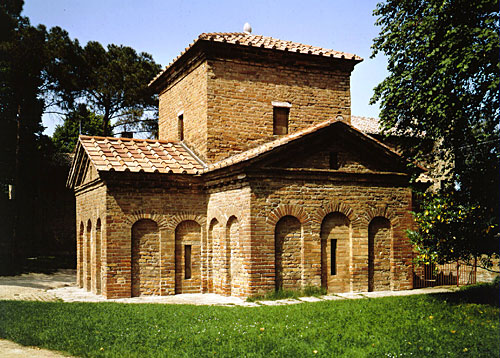
Ravenna -- the "new" Rome

Rome was the capitol of the Roman Empire. However, Constantine moved the capital from Rome to
the Greek City of Byzantium and renamed that city Constantinople (today that some city is Istanbul in Turkey). Constantine eliminated the tetrarchy, but he ended up dividing the Roman empire into a Western and Eastern
Empire.
The East expands and ultimately becomes the Byzantine
empire.
Constantine also divided the church:
In
Rome
— the Pope was the head of the church, with allegiance to God only. “Roman Catholic Church”
In Byzantium
— the head of the church was a patriarch with allegiance to both the government
and God. “Greek Orthodox Church.”
Ravenna is in Italy, which was part of the Western empire. As Italy was becoming weaker and weaker, Honorius, the Western emperor, moved the Western capital to Ravenna. It was a small Etruscan town, surrounded by swamps and easily defended. When Honorius died, his half-sister, Galla Placidia, took over the Western government for a short while. After her death, the town was captured by the Germans, then the Ostrogoths, and finally became part of the Byzantine empire.
Mausoleum of Galla Placidia, Ravenna, ca. 425
 |
 |
This monument is the “so-called Mausoleum of Galla
Placidia” and it was actually built about 25 years before her death. It was intended
as a family mausoleum and chapel. The exterior
is unadorned brick.
It is important because it combined two
early church plans — the longitudinal, basilican plan and the central plan.
Christ as the Good Shepherd, Mausoleum of Galla Placidia, Ravenna, ca. 425
|
|
|
|
Inside, the entire interior is covered with
mosaics. On the ceiling are stylized
stars against a blue background. At each
end is a lunette — a small arch.
In one of the lunettes, see Jesus as the Good Shepherd. He is young, beardless.
Sant’ Apollinare Nuovo, Ravenna, Exterior View,
dedicated 504

In 493, Theodoric, the king of the Ostrogoths,
established his capital at Ravenna. He
built his own palace-church. In the 9th
century, the relics of Saint Apollinaris were transferred to the church and it
was rededicated as “Sant’ Apollinare Nuovo.”
It was clearly designed as an Early Christian basilica. Once again, the exterior was unadorned brick.
Sant’ Apollinare Nuovo, Ravenna, Interior View

In the interior we see the central nave, the side aisles,
the apse, the clerestory windows, and the Greco-Roman columns that separate the
nave and the side aisles.
Above the columns is a mosaic frieze depicting a procession of worshipers
heading towards the altar. Between the
clerestory windows are depictions of saints and prophets. At the very top, above the clerestory
windows, are scenes from the life of
Jesus.
Miracle of the loaves and fishes, Sant’ Apollinare
Nuovo, Ravenna

This mosaic in one of the ones at the very top, and it
depicts the miracle of the loaves and fishes. As the biblical story goes,
by the Sea of Galilee, some 5000 people come to hear
Christ talk. One fish and several loaves
of bread were all the food available. Miraculously, these meager
portion fed all 5000 people.